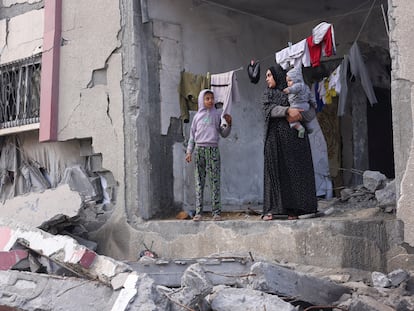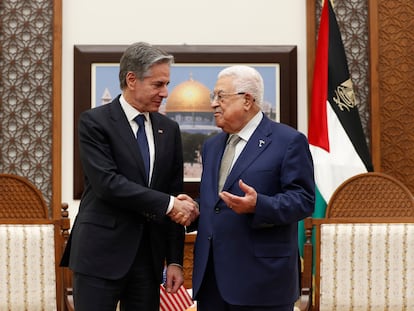Voting in war at the gates of Gaza: ‘We have 20 seconds to get to the shelter’
Israel holds anomalous municipal elections with low voter turnaround in which tens of thousands of evacuees will not cast their ballot until November
Married couple Rachel and David Edry survived inside their home in the city of Ofakim for 15 hours with five Hamas militiamen on October 7. She cooked for them, sang to them, and communicated with them in rudimentary Arabic. Later, police and civilians stormed the house. “If we die, we die together,” she thought at the time, according to her testimony to local media. The armed Islamists were annihilated and the couple emerged unscathed with Rachel becoming a national hero. On February 27, an obituary on the gate of the house — still riddled with bullet holes from the attacks — announced that David had died the day before. The couple’s neighbors lamented the fact that he survived the massacre and yet, less than five months later, he will be buried.
February 27 was municipal election day in Israel. In Ofakim and other cities, the faces of the electoral candidates form a mosaic in the streets that clashes with the omnipresent images of the 240 hostages taken to Gaza by Hamas last October. In the Mishor Hagefen neighborhood of Ofakim, the atmosphere remains tense. David Edry’s death is just a drop in the bucket of grief and pain.
“We’re just like we were that day. We haven’t just snapped out of it,” sighs Ilana Bugnik, 60, who lives two houses down the road from the Edry family. She responds reluctantly when asked about the polls. “I don’t feel like going to vote. If at all, later,” she says, more focused on explaining that she is being assisted by a social worker and that local residents are asking for more help.
“We have become sad people. We live in a lot of fear and we don’t feel like doing anything,” adds Mazal Yosef, 38, as she points to her apartment in the block across the street. This area was a living hell that fateful Saturday in October 2023, when the war began with the deaths of 1,200 Israelis in the attacks by Palestinian extremists. “Our hearts ache for the dead and we thank those who saved us,” adds Yosef, who has not gone to exercise her right to vote either.
The face of the current mayor, Itzik Danino, who is running for reelection, is displayed on canvases in almost every street. His chief of staff, Asaf Maze, 42, optimistically defends his wartime management. “October 7 changed everything. People assume that life goes on and we want to come out of all this stronger. Voting helps us to look to the future and fight the pain,” she says, in an attempt to cling to the path of normalcy that the women in the Mishor Hagefen neighborhood see as such a distant prospect. But it is not easy. Smadar Dahan, 55, says she still suffers nightmares when she remembers coming face to face with Hamas fighters. “It was like watching a movie,” she recalls, while also closing ranks around Danino.
Elections take a back seat
Ofakim, 25 kilometers (15.5 miles) as the crow flies from Gaza and with a population of around 25,000 people, was the farthest point in the Palestinian enclave that Hamas managed to hit on October 7. The municipal elections, scheduled for October 31, were postponed first to January and then to February 27 because of the ongoing conflict. Although thousands of inhabitants fled, Ofakim was not officially evacuated, unlike other localities closer to the Gaza Strip and the border with Lebanon, where mayors and other officials will not be elected until November.
In the rest of the country, the elections were held in a rarefied atmosphere. Everyone’s thoughts are occupied by the war, so the call to the ballot box has taken a back seat. At 7 p.m. local time Thursday, turnout stood at 41%, eight percentage points lower than at the same time in the previous elections in 2018. In Israel, election day is declared a public holiday, but many preferred to take advantage to go to shopping malls or shelter at home from the rain and cold outside. In a further example of the anomaly of the situation, Israeli soldiers have been able to cast their vote even inside Gaza, by a system known as “double envelopes,” which is also used by diplomats and prisoners and computed at the end of the poll.
Turnout was particularly low in the large cities. In Tel Aviv and Haifa, for example, it did not reach 30%. In the days leading up to the vote, fears circulated that the Lebanese militia Hezbollah would take advantage of election day to launch rocket attacks against the center of the country. In addition, the forum representing the families of some 130 hostages still held captive in Gaza deployed activists in the streets to insist that the apparent normality of holding elections does not mean they should be forgotten. “We elected the hostages” was the slogan they sported on T-shirts.
Sderot, the Israeli city closest to Gaza, is one of the places where the ballot boxes will have to wait. Nevertheless, the population has begun to return, cranes are working on buildings under construction, and the shopping center has reopened in a town that almost borders the Palestinian enclave. Some of its houses are just over a kilometer (0.62 miles) away. Elsayaf Levi is a military reservist whom the Hamas attack turned into a tank commander. Over these four long months, he has fought in Gaza, but has not returned to his home in Sderot. He is taking advantage of a few days of leave to accompany his wife to pick up some household goods, but for the time being they will continue to live with relatives.
In Ashkelon, a coastal city located about ten kilometers (6.2 miles) north of Gaza, even before the war residents were accustomed to living under the threat of rockets fired by Hamas. A well-oiled security protocol is in place, and it is not something they have to prepare for on an occasion such as election day. In the first 10 days of the war alone, more than 1,000 rockets were fired at the city from Gaza, according to figures provided by the authorities.
“If they fire and the alarms go off, we have about 20 seconds to get to the shelter,” says Yosef Kooper, 18, pointing to his left at the ORT Adivi school, one of the voting centers. The young man, wearing a fluorescent vest, is one of those helping voters figure out where to cast their ballot. The flow of voters is constant, but without large crowds. Before entering the classrooms where the ballot boxes are located, they pass the faces of those kidnapped by Hamas, which are hung in the schoolyard on a tarpaulin.
The black sky unloads a downpour that is almost welcome among those entering and leaving the center. They know the rain could just as easily be missiles. They are warned in case of an attack, which would force voting to be interrupted. “If the sirens go off, we run to the shelter, find a wall, or just drop to the ground,” explains Robert Sufaru, 75, who was born in Romania and came to Israel when he was three. “We are calm. Life must go on,” he stresses. “I’m not afraid, but I don’t want to be reminded that we are at war,” says Seagal Shalom, a 53-year-old woman who, like Sufaru, supports the re-election of the current mayor of Ashkelon, Tomer Glam.
Following the asphalt to the south, around the perimeter of Gaza, the clouds offer some respite. For a few seconds, the sun’s rays illuminate the buildings of the enclave, where almost 30,000 Palestinians have died in the current conflict. Military checkpoints increase and drones and helicopters buzz in the sky, while every now and then tanks rumble, leaving a trail of black smoke in the air. Some onlookers, equipped with binoculars, stop their car to contemplate the spectacle of war for a few minutes. A man armed with a rifle addresses about 20 visitors at a gas station at the entrance to Kibbutz Kfar Aza, barely 1,000 meters from the fence separating Israel from the Gaza Strip and one of the scenes of the carnage unleashed by Hamas. “And this is what happened on October 7,” the guide concludes amid the silence of those present.
Sign up for our weekly newsletter to get more English-language news coverage from EL PAÍS USA Edition
Tu suscripción se está usando en otro dispositivo
¿Quieres añadir otro usuario a tu suscripción?
Si continúas leyendo en este dispositivo, no se podrá leer en el otro.
FlechaTu suscripción se está usando en otro dispositivo y solo puedes acceder a EL PAÍS desde un dispositivo a la vez.
Si quieres compartir tu cuenta, cambia tu suscripción a la modalidad Premium, así podrás añadir otro usuario. Cada uno accederá con su propia cuenta de email, lo que os permitirá personalizar vuestra experiencia en EL PAÍS.
¿Tienes una suscripción de empresa? Accede aquí para contratar más cuentas.
En el caso de no saber quién está usando tu cuenta, te recomendamos cambiar tu contraseña aquí.
Si decides continuar compartiendo tu cuenta, este mensaje se mostrará en tu dispositivo y en el de la otra persona que está usando tu cuenta de forma indefinida, afectando a tu experiencia de lectura. Puedes consultar aquí los términos y condiciones de la suscripción digital.
More information
Archived In
Últimas noticias
‘Sleepless City’: The light of cinema illuminates Madrid’s Cañada Real shantytown
All the effects of gentrification in one corner of Mexico’s Colonia Roma
Palestinian reporter Youmna El Sayed: ‘My family told me I had to choose between being a journalist or a mother’
The new language of the workplace: Knowing how to ask AI questions is more important than using it
Most viewed
- The low-cost creative revolution: How technology is making art accessible to everyone
- Christian Louboutin: ‘Young people don’t want to be like their parents. And if their parents wear sneakers, they’re going to look for something else’
- US sanctions against jailed cartel leader ‘El Marro’ highlight Mexico’s lack of control over its prisons
- Liset Menéndez de la Prida, neuroscientist: ‘It’s not normal to constantly seek pleasure; it’s important to be bored, to be calm’
- ‘El Limones’ and the growing union disguise of Mexican organized crime










































